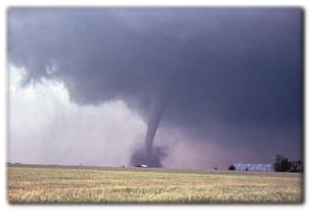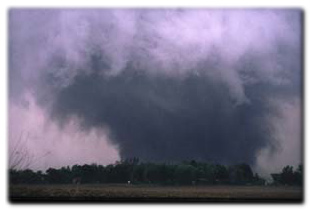
|
|
|
Dedications for Scribe Weekly Radio
|
BY Wijke Ruiter The National Weather Service (USA) reports Friday May 3, 2002:" More tornadoes for Maryland, Ohio. Meteorologists confirm that a tornado hit Maryland last night, the second to wreak havoc on the state in four days. Thunderstorms brought the tornado, large hail and heavy rain, damaging more than 12 homes and barns. trees snapped as the storm moved east... No one was injured" A tornado develops as every normal shower; but the process is far more faster and stronger in regions where air-masses with huge differences in temperature meet. In the USA this region is called the "Tornado Alley" where cold air-masses from Canada meet the warm, subtropical air from the Gulf of Mexico. The warm, moist air rises with high speed -so called updrafts -; a little low at the ground as result. The air -with water-vapour -
around this low
rotates
A tornado can be extremely
violent; asking victims every
year and bringing lots of damage to everything that is found on its
path. The
Japanese meteorologist Fujita has set up a tornado-strength-scale. The
F0 is the
lightest tornado with wind speed of 40-72 mph, the heaviest is F6 with
wind speeds
of 319-379 mph. The heaviest tornado's that occur in the Tornado Alley
are F4
and F5; with wind speeds of 207-318 mph. Houses and cars are swept
away, trees
snap, huge constructions are damaged easily. Such F4 and F5's exist
about a few
hours leaving a destructions-trail of about 70
miles. Of course this extreme weather will also attract people to watch the scene. There are loads of storm chasers in America risking their lives to experience the omnipotence of nature. They leave us their stories and pictures. You can find them for example
on the following websites:
|

 and cools down: the rotation
will be visible while the vapour condenses. A
jetstream at 5 to 6 miles height will give an impulse to this process,
as the
updraft is drawn away in this stream. (it works like a chimney). As
soon as this
circulation comes down to the ground a condensation funnel will be
visible and
the tornado is born.
and cools down: the rotation
will be visible while the vapour condenses. A
jetstream at 5 to 6 miles height will give an impulse to this process,
as the
updraft is drawn away in this stream. (it works like a chimney). As
soon as this
circulation comes down to the ground a condensation funnel will be
visible and
the tornado is born. 